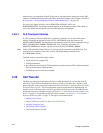
308
Dialogic Corporation
Source address is “sips:” URI, destination address is “sip:” URI
In this scenario, the transport protocol of an initial INVITE is determined using the same process as
in the “sip:” source/“sip:” destination case. Global Call will always use a “sips:” URI as the local
contact URI unless the application specifically changes it, which means that the subsequent
incoming request message should use TLS because the local URI is “sips:”
The following figure illustrates the scenario for an initial INVITE where the source address is a
“sips:” URI but the destination is a “sip:” URI. In this case, the initial INVITE is UDP because of
the “sip:” destination address but the BYE is TLS because of the “sips:” URI in the source address.
Figure 55. TLS with “sips:” Source Address and “sip:” Destination Address
App TLS
Server
Global Call
INVITE sip:friend@remote.com SIP/2.0
To:<sip:friend@remote.com>
From:<sips:user@local.com>
Via: SIP/2.0/UDP xxxxxx
Contact: <sips:user@local.com>
200 OK
To:<sip:friend@remote.com>
From:<sips:user@local.com>
Via: SIP/2.0/UDP xxxxxx
Contact: <sip:friend@remote.com>
ACK
To:<sip:friend@remote.com>
From:<sips:user@local.com>
Via: SIP/2.0/UDP xxxxxx
Contact: <sips:user@local.com>
200 OK
From:<sip:friend@remote.com>
To:<sips:user@local.com>
Via: SIP/2.0/TLS xxxxxx
GCEV_DROPCALL
GCEV_RELEASECALL
gc_ReleaseCall()
gc_DropCall()
GCEV_CONNECTED
gc_MakeCall()
destination.address =
"sip:friend@remote.com"
origination.address =
"sips:user@local.com"
With TLS server configuration.
gc_Start()
App TLS
Client
Global Call
gc_Start()
GCEV_OFFERED
gc_Answer()
GCEV_ANSWERED
GCEV_DROPCALL
gc_ReleaseCall()
GCEV_RELEASECALL
With TLS client configuration.
gc_DropCall()
BYE
From:<sip:friend@remote.com>
To:<sips:user@local.com>
Via: SIP/2.0/TLS xxxxxx
GCEV_DISCONNECTED


















